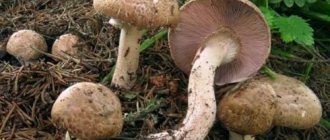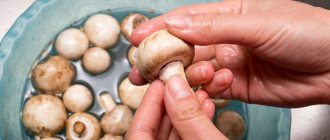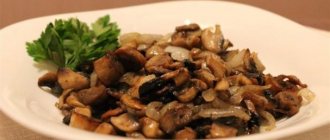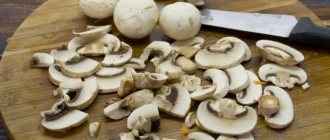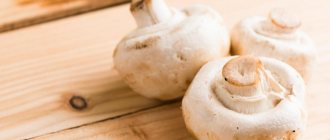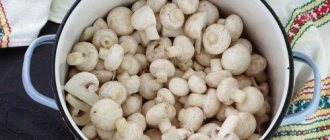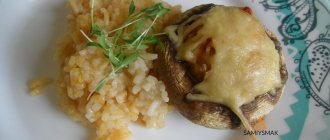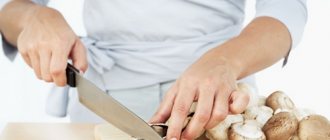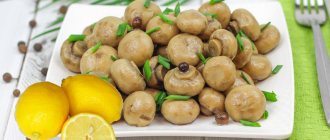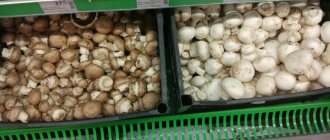Champignons are the most popular mushrooms in the world. They are tasty, aromatic and very healthy, suitable for both everyday and holiday dishes. Let's figure out how to choose and store them correctly.
It's time to pickle mushrooms for the New Year's table. Or maybe you would like to make stuffed champignons as an appetizer? However, even if you do not plan to include mushrooms in the New Year's menu, but use them in your dishes, it is useful to know how to choose good champignons.
The thing is that champignon is the safest mushroom that can even be eaten raw. But if it is spoiled, it immediately becomes poisonous, so if you have suspicions about the freshness of the mushrooms, it is better not to risk your health - throw them away.
What champignon mushrooms look like
Adult fruiting bodies, fully ripe and ready for harvest, are represented by a massive, fairly dense, rounded or flatter cap with a white or brownish surface, smooth or covered with dark scales. The plates are loose, white, but darken with age. The leg is centrally located, smooth and most often dense. May be hollow inside. There is a partial cover, represented by a clearly visible one- or two-layer ring. The pulp may have various shades of whitish color.
Choice when purchasing
You need to be careful when choosing a product in a store or on the market: first you should study its description, because it is from the industrial label that you can find out the date, batch number and expiration date. When buying wild mushrooms at the market, other signs will help determine their freshness. First of all, those who want to prepare high-quality food need to pay attention to the color: a suitable product should look white or slightly creamy.
Did you know? Unscrupulous
Employees of some stores bleach mushrooms with bleach
. strictly forbidden to eat such champignons , and it is not difficult to identify a fake: even if you boil or fry them,
they
still
remain white.
If the mushroom is darker in color or generally has a pronounced brown tint, it can already be considered old and unsuitable for consumption. Overripe champignon is not dangerous for the human body, but after cooking it becomes tough. If the caps have already become covered with dark spots or black dots, this means that the mushrooms have been lying on the shelves for a long time. Carefully inspect the space between the stem and the cap: if the film connecting them is damaged, then you have a stale mushroom that has begun to deteriorate.
It is imperative to check the external condition of the fruiting body of the mushroom. Fresh champignon is characterized by sufficient elasticity and firmness. If it is easily compressed when pressed, and dents remain on the surface, it is better to refuse the purchase. Run your finger over the surface of the mushroom. If the cap and stem are slippery and there is mucus on them, then the product is clearly rotten. The aroma will always help to distinguish a bad mushroom from a good one.
Did you know? Champignons help with weight loss because they contain almost no fat or carbohydrates. The calorie content of the product is only 27 kcal if it is not fried, but simply boiled or baked.
It should not contain notes of dampness or acidity, which are a sign that the mushrooms were picked a long time ago and were stored incorrectly. This product cannot be cooked. Very often you can find already packaged and packaged mushrooms. Before purchasing such a product, be sure to inspect the packaging. There should be no drops of water inside: excessive moisture can spoil the mushrooms in a couple of days.
Photo gallery
Where they grow, in what forests and how to collect
In Russia, mushrooms are widespread. Especially many of them can be found in the European part of the state.
You should go in search of champignons in steppe and forest-steppe zones. Myceliums are mainly located in open clearings and on the sides of forest roads. But some specimens can also be found in dense thickets. A large number of myceliums are concentrated in fields, meadows, and pastures. They grow in soils rich in humus or on the bark of dead trees.
On a note! The fruiting period begins in May and lasts until mid-autumn. The peak season is in August.
Composition and beneficial properties of champignons
Mushrooms belong to the category of dietary and low-fat foods. 100 g of mushroom pulp contains approximately 26-27 kcal. Fresh mushrooms are lower in calories. The composition is 4.3 g protein, 1.0 g fat, 0.1 g carbohydrates, 1.0 g ash and 91 g water. The benefits of such a product for the human body are also undeniable, which is due to the presence of a significant amount of phosphorus in the composition, which allows:
- normalize metabolic processes;
- tone the body;
- relieve feelings of fatigue;
- relieve irritability;
- calm the nervous system;
- reduce the risk of heart attack or stroke;
- restore the functions of the stomach and intestines;
- suppress appetite.
The product improves memory and concentration, has a positive effect on the condition of the visual organs, and helps strengthen the connective tissues of the body, including bones, teeth, skin, hair and nails. Mushroom juice can have a bactericidal effect. Dry mushroom powder is useful in the treatment of hepatitis and gastric ulcers.
Signs of spoiled canned champignons
It is better to throw away suspicious mushrooms
Canned mushrooms have an extended shelf life, but if the preservation technology is violated under the influence of pathogenic bacteria, they can deteriorate in a short period of time.
The following will tell you that canned champignons have spoiled and are not suitable for food:
- cloudiness of the marinade or saline solution (peculiar inclusions become noticeable in it);
- swelling of the metal lid of the jar, which is provoked by gases released by actively reproducing microorganisms (when pressed, it is pressed);
- air bubbles rising from the bottom inside, which signals the beginning of the fermentation process;
- acrid “carbonated” (in the nose) smell when opening the can;
- mucus or pieces of mold on products removed from the jar.
Any of the above signs is a reason to throw away the mushrooms. Even in the absence of external symptoms of the fermentation process and others indicating a violation of the canning technology and the presence of pathogenic microorganisms, canned food with an expired expiration date and with violation of storage conditions, under which the temperature should not exceed +30°C, are not suitable for consumption.
Irina Selyutina (Biologist):
There is another sign of spoilage in canned champignons (and other mushrooms too) - a sour taste. However, as long-term statistical data on poisoning from spoiled canned products show, when preservation technology is violated or stale raw materials are used, botulism bacillus, a deadly disease, develops in the marinade under favorable conditions. Therefore, you should not taste spoiled canned mushrooms - this will only lead to serious food poisoning. Since such a product cannot be rehabilitated, it is better to destroy it.
To prevent this from happening, approach the process of preserving mushrooms very carefully and responsibly, because the health and well-being of loved ones is the happiness of every woman.
Harm and contraindications of mushrooms
Despite the significant number of beneficial properties that mushroom pulp contains, some contraindications should also be taken into account:
- children's preschool age;
- disturbances in the functioning of the stomach and intestines;
- liver dysfunction;
- individual intolerance.
You should be careful when consuming mushroom dishes if you have a history of unknown allergies. It is also important to remember that strong heat treatment of fruiting bodies makes them less nutritious and healthy.
Is it possible to eat blackened champignons?
Many people who are just starting to cook on their own often ask the question: can they be eaten if the champignons have darkened? In this case, the answer depends on many factors and phenomena, for example, the presence of signs of spoilage, shelf life, method of heat treatment, and so on. The fact is that under certain conditions, blackening of mushrooms is the norm and such champignons can be eaten with peace of mind. All these points will be described in detail in the article below.
Edible types and varieties of champignons
Some species grow exclusively in forests (A.silvaticus and A.silvicola), and soil saprotrophs (A.bisprorus, A.bitorquis and A.subperonatus) grow in open spaces, among grass stands of different heights. Among other things, there are desert species, which include A. bernardii and A. tabularis.
Field champignon
A.arvensis has a fruiting body of quite large size, with a thick, fleshy, rounded-bell-shaped or convex-spread cap, in the center of which there is a small tubercle or slight flatness. The pulp is white or cream-colored, with an almond or anise aroma. An ocher tint and slow yellowing may be present. The surface part is silky or smooth, covered with yellowish or brownish scales. The plates are often located and characteristically swollen. The leg area is cylindrical, smooth, with widening or thickening at the base. The spores are black-brown.
Forest champignon
The fruiting body of A.silvaticus has an ovoid-bell-shaped or flat-spread cap, often with a protruding mound, rusty-brown color, with a large number of dark scales. The pulp is white in color, turning red when cut. The plates are white, reddish or dark brown, tapering at the end. The leg area is cylindrical, slightly swollen at the base, with a whitish membranous ring.
Common champignon
A. сampestris has a hemispherical cap with inwardly curved edges, a flat-round or prostrate shape. The central part is convex. The surface part is white or brownish in color and can be dry, silky or finely scaly. The pulp is white in color, turning red when cut. The plates are white, pinkish or dark brown in color, with a purple tint. The pedicle area is straight and smooth, with a widening or swelling at the base, with the presence of a wide whitish ring.
Champignon fine-scaled
A.squamuliferus is distinguished by a thick, fleshy, initially semicircular, later convex-spread cap, with a wide and blunt tubercle. The surface part is fine-scaled, silky. The stalk area is cylindrical, sometimes with a slight tuberous base, white, silky-fibrous type. The flesh is white, turning pink or red at the break. Spore powder is dark brown in color. The plates are of a free type, often located, brownish in color. The spores are ellipsoidal in shape, with a smooth surface, and light brownish in color.
Garden champignon
A. bisporus has a rounded cap, with curved edges and the presence of a residual private cover, represented by thin flakes, pure white or with a brownish tint. The surface part of the cap is smooth, glossy in the central part or radially fibrous, sometimes with scales. The pulp is dense and juicy, acquiring a pinkish or red tint when cut. The plates of young specimens are pink in color. With age, the plates become dark brown with a characteristic purple tint. The leg is cylindrical, pinkish in color, with a well-defined ring.
Champignon dark red
A.haemorrhoidarius is characterized by a convex or conical cap with a blunt apical part. At the ripening stage, the cap opens to an almost completely flat shape . The skin on the surface is brownish-brown, cracking into separate fibrous scales.
The pulp is white, becoming thick red when cut. It has a not too pronounced mushroom or sour aroma, and also has a mild and pleasant taste. The stem is off-white in color, with a hollow interior and a scaly surface below the ring. At the base of the leg there is a noticeable thickening, immersed in the ground. The membranous ring is well defined. The plates are of a free type, often arranged, light pink in color.
Champignon stocky
A.spissicaulis is similar to the previous species and has a hemispherical cap that quickly opens to an almost flat cap. The skin is whitish in color, with a smooth surface that is prone to cracking and the formation of brownish-yellow scales. The edges are turned down. The pulp is whitish in color, noticeably thick in the cap part. When cut, a grayish-red tint appears and there is a noticeable almond aroma . The leg is club-shaped. The plates are freely and relatively sparsely spaced, reddish or chocolate-blackish brown.
Choose by size
A good seller will have all the champignons in a package or bag of approximately the same size. If you see both small and large champignons in the same package, and also in different colors (some are white, others are brownish or with spots), it means that an unscrupulous seller or supplier mixed fresh and stale mushrooms.
- Small champignons. These are the champignons that can be eaten raw - these are the youngest and freshest mushrooms. They are ideal for pickling, preparing salads, and decorating dishes. They need to be cooked quickly; they are not suitable for long stewing.
- Medium champignons. If you like mushroom soup or fried champignons with potatoes, know that for such purposes it is best to choose medium-sized mushrooms. They are good to put on pizza or to make mushroom pates - medium-sized champignons are very flavorful.
- Large champignons. There is an opinion that large mushrooms are tasteless, and their open cap is a sign of spoilage. Not at all! Large champignons are the most fragrant and are considered the most delicious. They are ideal for baking in the oven or grilling, stuffing, and make the most delicious pies.
Poisonous and dangerous doubles of champignons
There are several toxic varieties, as well as deadly and poisonous lookalikes that resemble the edible species in appearance.
Yellow-skinned champignon
A.xandhodermus is a fairly common poisonous species in natural conditions. The external description is similar to the edible species A.arvensis. It is characterized by a bell-shaped, slightly curved edges, fleshy, white or whitish-brown colored upper part. The pulp becomes yellow when pressed. The surface part is smooth and dry, prone to cracking. A significant difference is the presence of an unpleasant phenolic or inky odor. The leg is hollow, distinctly white, with a noticeable swelling at the base.
Flat-headed champignon
A.Placomyces is one of the most poisonous species. The cap is conical, then convex and broadly convex in shape with a fairly flat central part and rolled up edges.
The surface is white, covered with gray or grayish-brown scales. The central part has a very characteristic gray-brown color. The cap plates are freely arranged, white, pink and chocolate brown. The pulp is white, with intense yellowing on the cut and the presence of a sharp inky or phenolic odor. The leg is cylindrical in shape, with a club-shaped thickening at the base.
Californian champignon
A. californicus is a poisonous variety characterized by a dry, whitish or brownish cap with a darker central part and a noticeable metallic tint. The surface may be bare or covered with numerous scales. The cap edges on young specimens are turned inward. The pulp does not change color or is slightly darker when cut , and also has an unpleasant phenolic odor. The pedicle area is most often curved and has a characteristic membranous ring.
Symptoms of champignon poisoning
If a person is poisoned by champignon, the consequences and symptoms will not take long to appear. On average, after 2 hours a person’s stomach begins to hurt, he feels nauseous, and sometimes diarrhea occurs. As with any other poisoning, some signs of intoxication occur. The most common are sweating, headache, fever, fatigue, weakness, rapid heartbeat and breathing. To avoid serious consequences and undergo rehabilitation as quickly as possible, you need to quickly provide professional medical assistance. To do this, the victim must be taken to the appropriate hospital: call an ambulance or drive yourself to the clinic by car.
How to distinguish false champignon
Pale toadstool, stinking fly agaric, as well as spring or white fly agaric, in appearance, are quite reminiscent of young edible champignons. Most often, inexperienced mushroom pickers confuse edible varieties with poisonous toadstool, so it is very important to know the main differences:
- has a fibrous surface and smooth edges;
- surface coloring varies from whitish to pale, greenish-olive or grayish;
- young specimens have a hemispherical cap, while older specimens have a spread or flat cap;
- the plates are always white and quite soft;
- at the base of the leg there is always a pronounced bulbous thickening or the so-called clover-shaped swelling;
- the pulp does not change color when cut;
- The mushroom aroma is completely absent.
It is important to remember that the false champignon or toadstool belongs to the category of deadly, poisonous varieties, and the mortality rate when eating such fruiting bodies is 70% or more.
Is it possible to eat expired champignons?
As mentioned in the article above, spoiled champignons should not be eaten under any circumstances. Spoiled mushrooms should be disposed of, and care must be taken to ensure that pets, out of curiosity, do not decide to try this food from the trash can. Since people and animals easily get the most serious food poisoning, the consequences of which will be described in detail in the article below. Expired champignons should not be eaten even after further heat treatment, including frying.
What happens if you eat spoiled champignons?
After a couple of hours, any person will begin to show signs of poisoning: abdominal pain, vomiting, intoxication (weakness, fever, fatigue, headache, bradycardia (slow heart rate), tachypnea (rapid breathing), increased sweating) and diarrhea. A person with mushroom poisoning should be taken to the hospital as quickly as possible: call an ambulance or drive yourself to the hospital. If professional medical assistance is not provided in time in case of severe poisoning from spoiled champignons, the consequences can be dire: serious problems with the gastrointestinal tract, long rehabilitation due to the consequences of poisoning, or even death.
Growing champignons in the garden
Growing or propagating edible mushrooms yourself in a garden plot is not too difficult, but before planting mushroom seeds or propagating fruiting bodies with mycelium, you need to familiarize yourself with the technology of home mushroom growing. The basic conditions for proper cultivation are presented:
- comfortable temperature range from 22 to 25ºС;
- optimal humidity levels within 85-95%;
- the presence of a gaseous environment and intensive ventilation with an influx of fresh air flows at different stages of growth and development;
- correct chemical indicators of the substrate with a neutral or slightly alkaline environment at pH 7-7.5;
- almost complete absence of direct lighting and the presence of shading. If necessary, plantings should be covered or shaded.
How to store it correctly?
So, you chose good fresh champignons, brought them home, but you don’t have time to cook right now. What to do?
- Place in the refrigerator. Do not wash or sort the mushrooms - just pour them into an open container (bowl, box) and place them on the middle shelf of the refrigerator. Fresh champignons can be stored in this form for up to 3 days.
- Put it in a bag. If you have paper bags, place the mushrooms in them and then place them in the vegetable storage compartment. This way they can stay for up to 5 days. You cannot transfer mushrooms, as rot will begin to develop in places with dents.
- To freeze. Mushrooms can be frozen fresh, boiled or fried. It is not recommended to refreeze mushrooms, so you can prepare them immediately: fresh ones - wash, peel and cut, and then pack them into portioned bags or containers. Mushrooms can be stored in the freezer for up to six months.
- Dry in the oven. This is a labor-intensive process, but the result is worth it. Peel and thinly slice the mushrooms. If you wash them, the color of the finished mushrooms will be darker, and they will take longer to dry. Place the sliced mushrooms in one layer on a baking sheet and place in the oven preheated to 45 degrees. After 6-7 hours, the temperature can be increased to 80 degrees and dried for another 18 hours, opening the oven door slightly.
- Dry on a thread. This is an easier way to dry mushrooms. Cut the mushrooms, put them on a string and hang them in a dry and ventilated but warm room. They will dry for 6-7 days. The finished dried champignons will not be too soft, they can be bent a little without breaking. You can store them in a linen bag or in a glass jar.
- Marinate. This is the most delicious way to preserve mushrooms. Just marinate them, roll them in a sterilized jar, and the finished snack will be available at any time of the year.
Don't miss useful information, subscribe to our Telegram channel!
4 829
Author: Ekaterina Stepanova
How to distinguish a champignon from a toadstool (video)
During the formation of primary mass primordia of fruiting bodies, it is very important to gradually, over five days, reduce the air temperature to 14-16 ºС. The room allocated for cultivation must be regularly and sufficiently well ventilated. When the very first mushrooms appear, irrigation measures are carried out daily, but in moderation. The average water consumption for each square meter of planting should not exceed one and a half liters of water. If the cultivation technology is followed, the harvest of fruiting bodies is formed in a wave-like manner over three or four months, with an interval of a week.
Collection is carried out at the stage of maximum size of the aerial part, at which the characteristic filmy cover under the cap should be completely preserved. In winter, it is necessary to pour snow on the roof, which will create a temperature favorable for growing inside the greenhouse space.
Champignons from the store
Purchased champignons need to be checked no less carefully than those you collect yourself in the forest. First of all, you should check whether the champignons are poisonous or normal (all the signs are written above in the corresponding section, and for an accurate determination, the mushrooms are boiled in ordinary water). It is equally important to make sure that the champignons are fresh and not spoiled - these signs have also already been discussed in as much detail as possible in the article above. Another important warning sign is that the price for champignons is too low. There will be no specific figure here, since the cost of champignons varies too much in different regions.
Stewed champignons with sour cream
This dish is suitable as an addition to lunch, or for dinner as a tasty and satisfying side dish.
Ingredients:
- fresh champignons – 500 gr.;
- bulbs – 2 pcs.;
- garlic – 2-3 cloves;
- vegetable oil;
- fat sour cream – 200-250 g;
- oil drain – 20 gr.;
- pepper, salt, herbs and other seasonings to taste.
Cooking method:
- Cut the mushrooms into small pieces. Heat a frying pan, pour in vegetable oil, and add mushrooms.
https://www.youtube.com/watch?v=KCd_-OK8ACw&feature=youtu.be - Pour oil into the second frying pan and add pre-chopped and peeled onions. The ingredients are fried separately, stirring occasionally.
- While the onions and mushrooms are frying, finely chop the greens. It must be added at the end. Also finely chop or grate the garlic.
- Once the mushrooms and onions are ready, combine them together. Add a piece of butter there and mix. Leave covered for 3-5 minutes.
- Then add salt, pepper, garlic and stir. Pour in sour cream and stir well again.
- Add dill at the end of cooking. Leave it covered for 2-3 minutes and turn off the heat.
If the sour cream is low in fat (less than 20%), then to prevent it from curdling, you can first add a small amount of flour.
